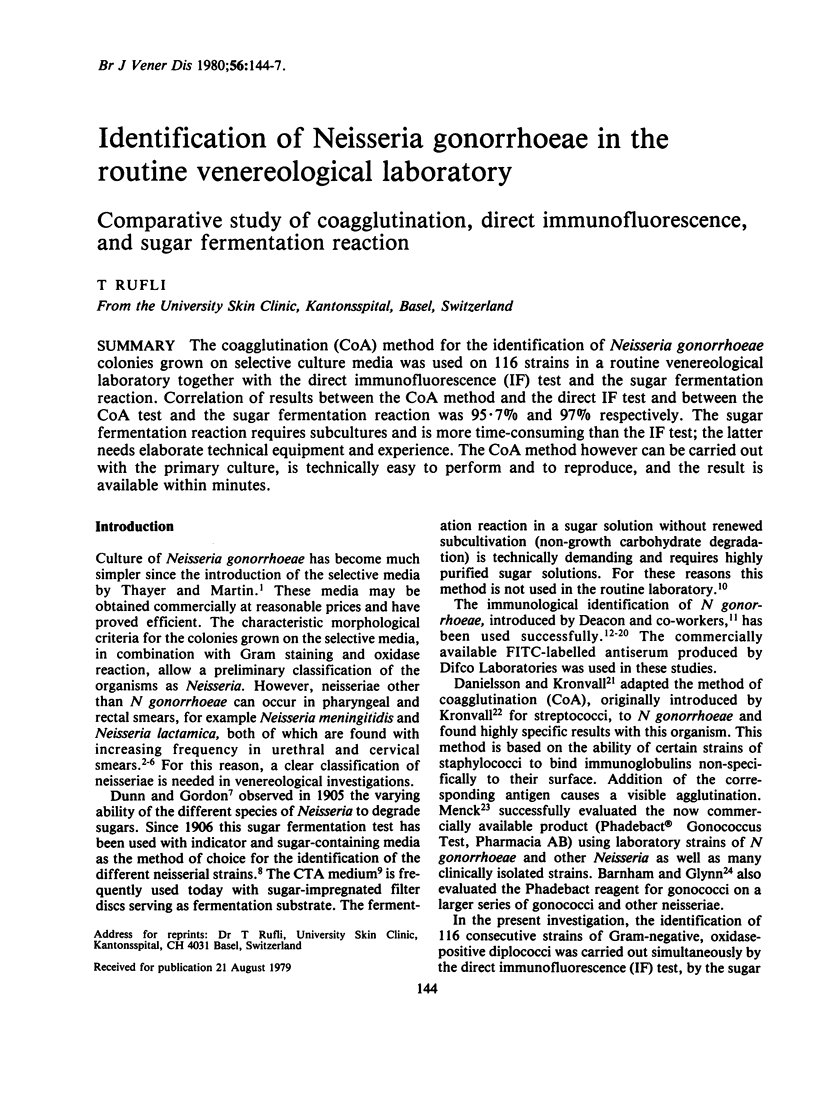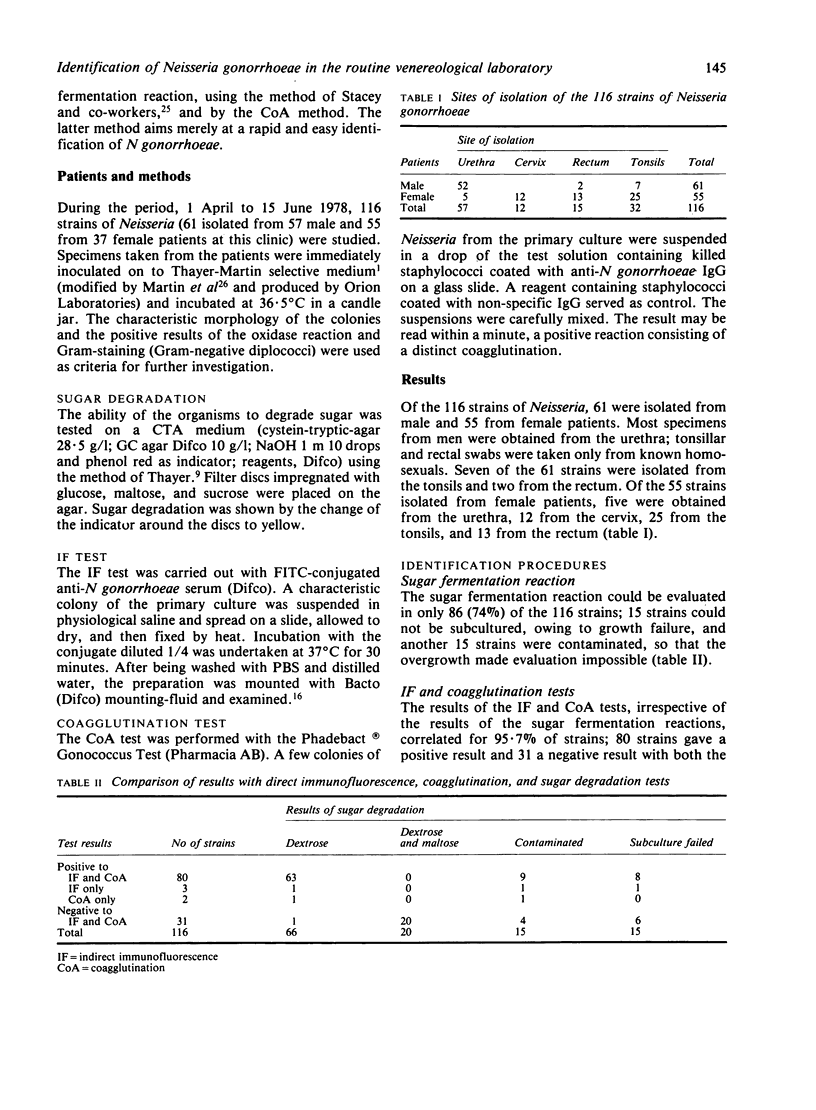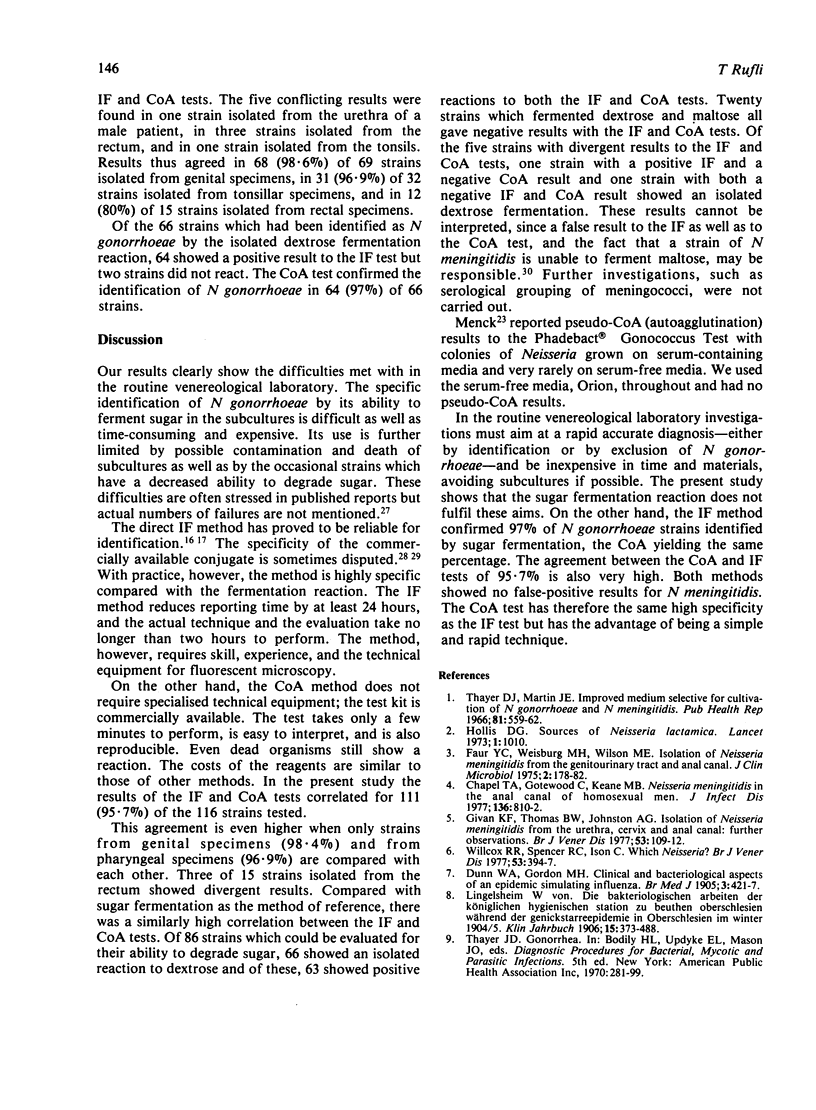Abstract
The coagglutination (CoA) method for the identification of Neisseria gonorrhoeae colonies grown on selective culture media was used on 116 strains in a routine venereological laboratory together with the direct immunofluorescence (IF) test and the sugar fermentation reaction. Correlation of results between the CoA method and the direct IF test and between the CoA test and the sugar fermentation reaction was 95.7% and 97% respectively. The sugar fermentation reaction requires subcultures and is more time-consuming than the IF test; the latter needs elaborate technical equipment and experience. The CoA method however can be carried out with the primary culture, is technically easy to perform and to reproduce, and the result is available within minutes.
Full text
PDF



Selected References
These references are in PubMed. This may not be the complete list of references from this article.
- Barnham M., Glynn A. A. Identification of clinical isolates of Neisseria gonorrhoeae by a coagglutination test. J Clin Pathol. 1978 Feb;31(2):189–193. doi: 10.1136/jcp.31.2.189. [DOI] [PMC free article] [PubMed] [Google Scholar]
- Barthelmes H., Mühler R., Droste K. D., Kern A. Die Herstellung, Testung und Anwendung eines artspezifischen, FITC-markierten Antigonokokkenserums. Dermatol Monatsschr. 1973 Oct;159(10):929–943. [PubMed] [Google Scholar]
- Beno D. W., Devine L. F., Larson G. L. Identification of Neisseria meningitidis carbohydrate fermentation patterns in Mueller-Hinton broth. J Bacteriol. 1968 Aug;96(2):563–563. doi: 10.1128/jb.96.2.563-.1968. [DOI] [PMC free article] [PubMed] [Google Scholar]
- Chapel T. A., Gatewood C., Keane M. B. Neisseria meningitidis in the anal canal of homosexual men. J Infect Dis. 1977 Dec;136(6):810–812. doi: 10.1093/infdis/136.6.810. [DOI] [PubMed] [Google Scholar]
- DEACON W. E., PEACOCK W. L., Jr, FREEMAN E. M., HARRIS A. Identification of Neisseria gonorrhoeae by means of fluorescent antibodies. Proc Soc Exp Biol Med. 1959 Jun;101(2):322–325. doi: 10.3181/00379727-101-24925. [DOI] [PubMed] [Google Scholar]
- Danielsson D., Kronvall G. Slide agglutination method for the serological identification of Neisseria gonorrhoeae with anti-gonococcal antibodies adsorbed to protein A-containing staphylococci. Appl Microbiol. 1974 Feb;27(2):368–374. doi: 10.1128/am.27.2.368-374.1974. [DOI] [PMC free article] [PubMed] [Google Scholar]
- Faur Y. C., Weisburd M. H., Wilson M. E. Isolation of Neisseria meningitidis from the Genito-urinary tract and anal canal. J Clin Microbiol. 1975 Sep;2(3):178–182. doi: 10.1128/jcm.2.3.178-182.1975. [DOI] [PMC free article] [PubMed] [Google Scholar]
- Gallwey J. M., Nicol C. S., Ridley M. Immunofluorescent antibody technique in the diagnosis of gonorrhoea by direct smears from the female. Br J Vener Dis. 1967 Sep;43(3):168–169. doi: 10.1136/sti.43.3.168. [DOI] [PMC free article] [PubMed] [Google Scholar]
- Givan K. F., Thomas B. W., Johnston A. G. Isolation of Neisseria meningitidis from the urethra, cervix, and anal canal: further observations. Br J Vener Dis. 1977 Apr;53(2):109–112. doi: 10.1136/sti.53.2.109. [DOI] [PMC free article] [PubMed] [Google Scholar]
- Hare M. J. Comparative assessment of microbiological methods for the diagnosis of gonorrhea in women. Br J Vener Dis. 1974 Dec;50(6):437–441. doi: 10.1136/sti.50.6.437. [DOI] [PMC free article] [PubMed] [Google Scholar]
- Henderson R. A., Rutherford S., Phelps J. A., Robertson P. Experience with a rapid direct immunofluorescent test for the gonococcus as a "bench" procedure in venereal disease clinics. Br J Vener Dis. 1970 Jun;46(3):205–208. doi: 10.1136/sti.46.3.205. [DOI] [PMC free article] [PubMed] [Google Scholar]
- Hollis D. G. Sources of Neisseria lactamicus. Lancet. 1973 May 5;1(7810):1010–1010. doi: 10.1016/s0140-6736(73)91666-8. [DOI] [PubMed] [Google Scholar]
- Jephcott A. E., Morton R. S., Turner E. B. Use of transport-and-culture medium combined with immunofluorescence for the diagnosis of gonorrhoea. Lancet. 1974 Nov 30;2(7892):1311–1313. doi: 10.1016/s0140-6736(74)90161-5. [DOI] [PubMed] [Google Scholar]
- Kellogg D. S., Jr, Turner E. M. Rapid fermentation confirmation of Neisseria gonorrhoeae. Appl Microbiol. 1973 Apr;25(4):550–552. doi: 10.1128/am.25.4.550-552.1973. [DOI] [PMC free article] [PubMed] [Google Scholar]
- Kronvall G. A rapid slide-agglutination method for typing pneumococci by means of specific antibody adsorbed to protein A-containing staphylococci. J Med Microbiol. 1973 May;6(2):187–190. doi: 10.1099/00222615-6-2-187. [DOI] [PubMed] [Google Scholar]
- Martin J. E., Jr, Lester A. Transgrow, a medium for transport and growth of Neisseria gonorrhoeae and Neisseria meningitidis. HSMHA Health Rep. 1971 Jan;86(1):30–33. [PMC free article] [PubMed] [Google Scholar]
- Menck H. Identification of Neisseria gonorrhoeae in cultures from tonsillo-pharyngeal specimens by means of a slide co-agglutination test (Phadebact Gonococcus Test). Acta Pathol Microbiol Scand B. 1976 Jun;84(3):139–144. doi: 10.1111/j.1699-0463.1976.tb01916.x. [DOI] [PubMed] [Google Scholar]
- Petzoldt D. Die Immunofluorescenz in der Gonorrhoe-Diagnostik. Arch Dermatol Forsch. 1972;244:288–290. [PubMed] [Google Scholar]
- Reichlin B., Rufli T. Zur Aussagekraft heute verfügbarer Gonorrhöe-Untersuchungsmethoden. Schweiz Med Wochenschr. 1974 Nov 30;104(48):1712–1717. [PubMed] [Google Scholar]
- Rufli T. Zur IF-Diagnostik der Gonorrhö. Dermatologica. 1973;146(5):269–280. [PubMed] [Google Scholar]
- Schmid E. E., Sonnabend W., Jung M., Krech U. Gonorrhöe oder unspezifische Infektion--Differenzierung durch direkte Immunofluoreszenz. Schweiz Med Wochenschr. 1971 Dec 4;101(48):1717–1724. [PubMed] [Google Scholar]
- Stacey P., Warner G. Identification of Neisseria gonorrhoea and Neisseria meningitidis by a carbohydrate disc technique. J Clin Pathol. 1973 Apr;26(4):303–304. doi: 10.1136/jcp.26.4.303. [DOI] [PMC free article] [PubMed] [Google Scholar]
- Thayer J. D., Martin J. E., Jr Improved medium selective for cultivation of N. gonorrhoeae and N. meningitidis. Public Health Rep. 1966 Jun;81(6):559–562. [PMC free article] [PubMed] [Google Scholar]
- Thin R. N. Immunofluorescent method for diagnosis of gonorrhoea in women. Br J Vener Dis. 1970 Feb;46(1):27–30. doi: 10.1136/sti.46.1.27. [DOI] [PMC free article] [PubMed] [Google Scholar]
- Tronca E., Handsfield H. H., Wiesner P. J., Holmes K. K. Demonstration of Neisseria gonorrhoeae with fluorescent antibody in patients with disseminated gonococcal infection. J Infect Dis. 1974 May;129(5):583–586. doi: 10.1093/infdis/129.5.583. [DOI] [PubMed] [Google Scholar]
- Willcox R. R., Spencer R. C., Ison C. Which Neisseria? Br J Vener Dis. 1977 Dec;53(6):394–397. doi: 10.1136/sti.53.6.394. [DOI] [PMC free article] [PubMed] [Google Scholar]


